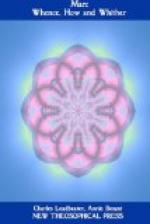I use these rude illustrations to make clear one point: Germ-plasm can easily change into somatoplasm, but somatoplasm once formed can never be reconverted into germ-plasm, any more than the fallen hero of the nursery rhyme could ever be restored.
The germ-plasm is, according to Weismann, a very peculiar, complex, stable substance, continuous from generation to generation since the first appearance of life on the globe. It is in the body of the parent, but scarcely of it. Its relation to the body is like that of a plant to the soil or of a parasite to its host. It receives from the body practically only transport and nourishment. It is like a self-perpetuating, close corporation; and the somatoplasm has no means of either controlling it or of gaining representation in it.
Says Weismann[A]: “The germ-cells are contained in the organism, and the external influences which affect them are intimately connected with the state of the organism in which they lie hid. If it be well nourished, the germ-cells will have abundant nutriment; and, conversely, if it be weak and sickly, the germ-cells will be arrested in their growth. It is even possible that the effects of these influences may be more specialized; that is to say, they may act only upon certain parts of the germ-cells. But this is indeed very different from believing that the changes of the organism which result from external stimuli can be transmitted to the germ-cells and will redevelop in the next generation at the same time as that at which they arose in the parent, and in the same part of the organism.”
[Footnote A: Essays upon Heredity, p. 105.]
But if the germ-plasm has this constitution and relation to the rest of the body, how is any variation possible? Different individuals of any species have slightly different congenital tendencies. Hence in the act of fertilization two germ-plasms of slightly different structure and tendency are mingled. The mingling of the two produces a germ-plasm and individual differing from both of the parents. Thus, according to Weismann’s earlier view, the origin of variation was to be sought in sexual reproduction through the mingling of slightly different germ-plasms.
But how did these two germ-plasms come to be different? How was the variation started? To explain this Weismann went back to the unicellular protozoa. These animals are undoubtedly influenced by environment and vary under its stimuli. Here the variations were stamped upon the germ-plasm, and the commingling of these variously stamped germ-plasms has resulted in all the variations of higher animals.
Of late Weismann has modified and greatly improved this portion of his theory. He now accepts the view that external influences may act upon the germ-plasm not only in protozoa but also in all higher animals. Variation is thus due to the action or stimulus of external influences, supplemented by sexual reproduction.




